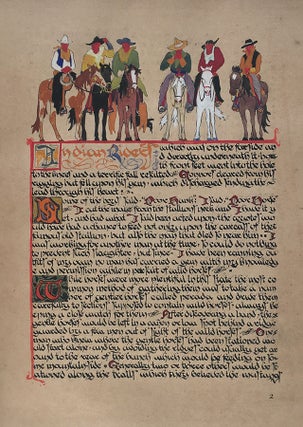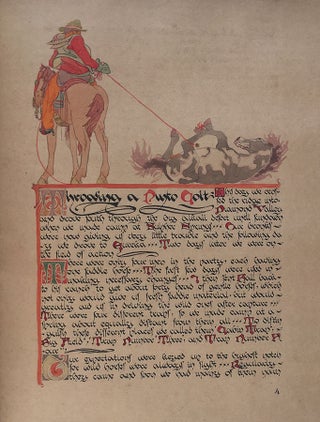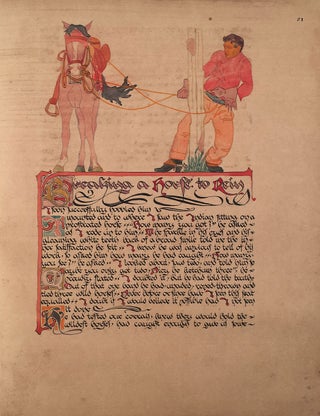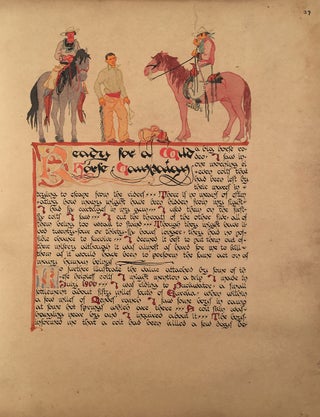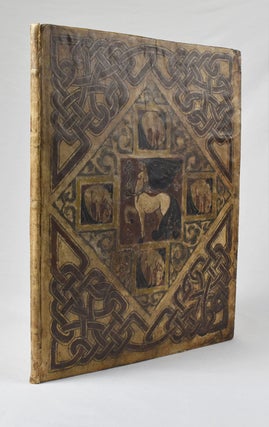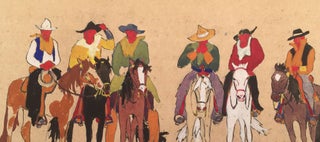How I Trap Wild Horses.
Paris, 1915. Folio, original mule hide with hand-painted Celtic knot and war cross with horse figures design. Illuminated calligraphic manuscript of 38 pp., with 19 original watercolors, including title-page illus., 1 full-page illus., 14 large head-pieces, 2 illus. in text, and 1 tail-piece; watercolor border designs and initials. A unique and truly delightful Arts & Crafts illumination of an account of the pursuit and capture of wild horses in Nevada, calligraphed, illustrated, and bound by San Francisco artist Otis Oldfield. This seems to be the only example in book form of horse-breaker Charles “Pete” Barnum’s vivid, first-hand account of this quintessential western subject. It was originally published in the August, 1908 issue of Sunset magazine. Oldfield created this manuscript while living in France during World War I, where he was for a time under the tutelage of a French bookbinder. In 1926, he added a note to an endpaper explaining that “The material covering this book is the original mule hide bass drum head of the famous 431st French Infanterie dissolved in 1915 through lack of sufficient members--they having perish[ed,] dying the year with their blood...it has the war cross because it’s regiment was honored with that distinction...” The cover designs, which are original paintings, consist of a central panel incorporating an image of a female centaur, joined with smaller panels incorporating images of horses, the whole forming a war cross set within a diamond shaped field and Celtic knot borders. The manuscript begins with a prologue, apparently composed by Oldfield, evoking the bygone days when native people and horses roamed the American plain, in keeping with the prevailing notion of “the vanishing race.” It begins “Friend and Brother was Savage to Horse” and ends “For the Redman’s race fades away, Closely followed by his Medicine-Dog.” This is followed on the next page by a colophon cast in language reminiscent of the fine press books of the Roycrofters and other Arts & Crafts era bookmakers. The title-page features an illustration of a spirited black stallion, its mane and tail animated by the wind. The first page of the text proper appears on the verso, incorporating a large colored initial letter “A” with an elaborate holly-leaf border and three additional colored initials. Opposite these opening passages is a delightful full-page portrait of Pete Barnum in his cowboy hat and chaps, arms akimbo, set against an orange background and surrounded by a foliated border, five fleurs-de-lis, and other ornamental elements. Barnum’s portrait and most of the illustrations that follow, which mainly depict the interactions of men and horses, are based on the photographs that illustrate the article in Sunset magazine. Comparison of the photographs with the illustrations makes for a very interesting study, and shows Oldfield following some fairly closely with minor but effective changes in detail, while using others more as a point of departure, eliminating or adding more significant details, altering and inventing compositions more his own. The result is a very charming book indeed. Painter and lithographer Otis Oldfield (1890-1969) was born in Sacramento, California on July 3, 1890. As a teenager he worked in a local print shop, and in 1909 arrived in San Francisco and enrolled at the Best Art School. In 1911, he left for Paris to study at the Académie Julian, and subsequently apprenticed himself to a bookbinder in Bouffémont. Oldfield returned to the United States in 1924 and soon became an instructor at the California School of Fine Arts in San Francisco. In 1934, he was selected as one of 26 WPA artists to paint murals in San Francisco’s Coit Tower, the subject of his mural being “Shipping Activities Inside the Golden Gate.” Subsequently, Oldfield taught at the California College of Arts and Crafts, retiring in 1952, although he continued to paint and teach at his home nearly until his death in May of 1969. Oldfield’s work is found in the collections of the Oakland Museum of California, San Francisco Museum of Modern Art, San Francisco Museum of Fine Arts, de Young Museum, and Brooklyn Museum. A unique and decidedly captivating western Arts & Crafts book. REFERENCES: Sunset, The Magazine of the Pacific and of All the Far West. August, 1908, Vol. XXI, No. 4, pp. [285]-305 pp.; Biography of Otis Oldfield in Askart at www.askart.com CONDITION: Good, rubbed and edge-worn, front cover slightly cockled with small losses, back cover with considerable paint loss, endpapers renewed, fairly dark dampstain to edges of inscription leaf, light dampstain and spotting to edges of most other leaves, a few illustrations with light offsetting from text, a few short tears.
Item #3489
Price: $9,500.00



